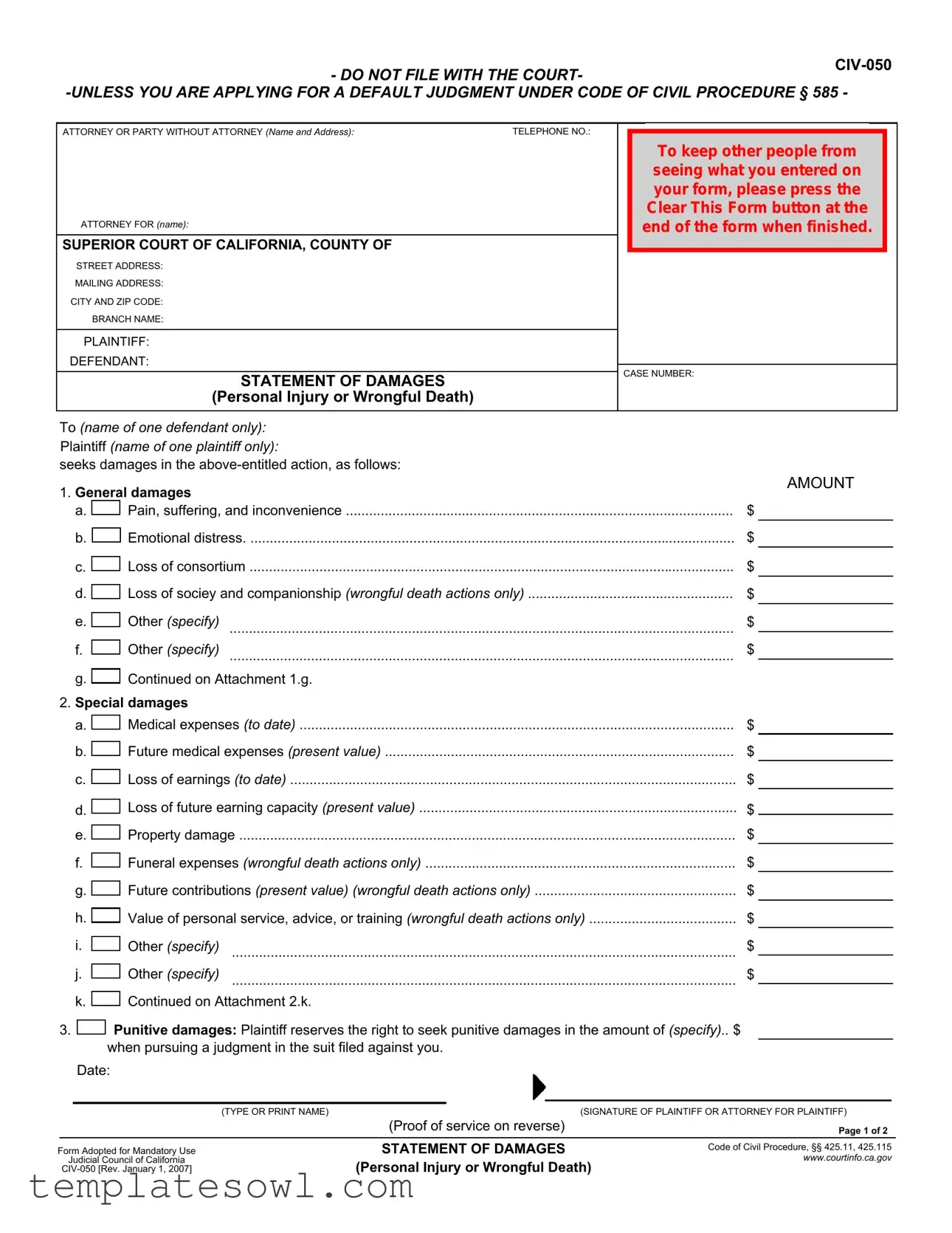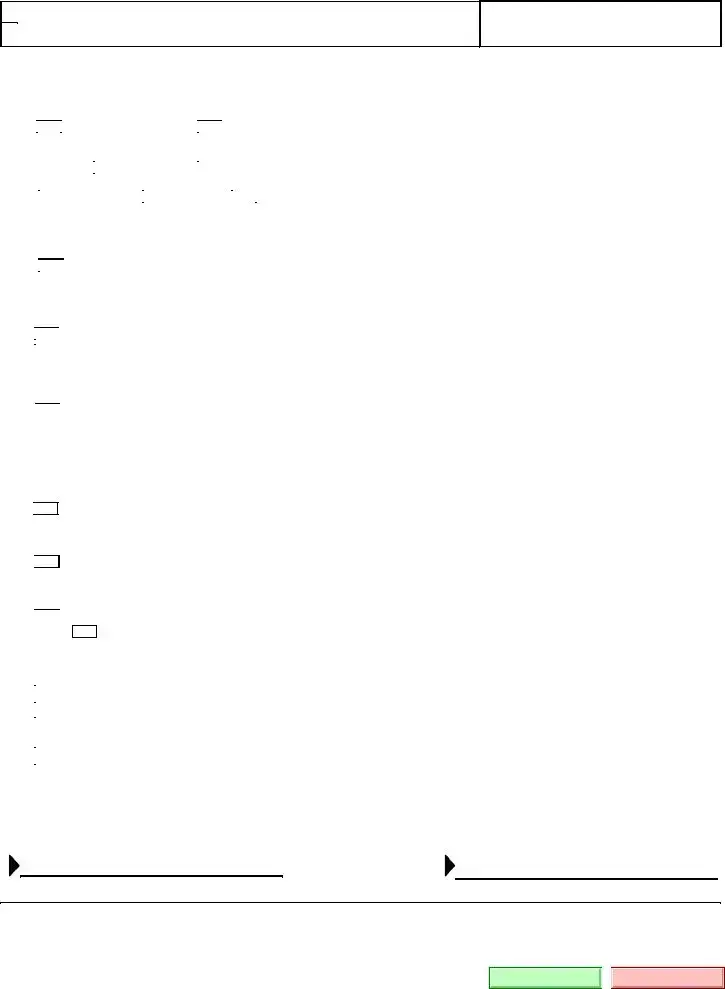f. Name, address and telephone number and, if applicable, county of registration and number:
(For California sheriff, marshal, or constable use only) I certify that the foregoing is true and correct.
Date:
(SIGNATURE)
PROOF OF SERVICE
(After having the other party served as described below, with any of the documents identified in item 1, have the person who served the documents complete this Proof of Service. Plaintiff cannot serve these papers.)
1.I served the
a. Statement of Damages
Statement of Damages  Other (specify):
Other (specify):
b.on (name):
|
|
|
|
|
|
|
|
|
|
|
c. by serving |
|
defendant |
|
other (name and title or relationship to person served): |
|
|
d. |
|
by delivery |
|
at home |
|
|
at business |
|
|
|
|
(1)date:
(2)time:
(3)address:
e.  by mailing
by mailing
(1)date:
(2)place:
2.Manner of service (check proper box):
a.  Personal service. By personally delivering copies. (CCP § 415.10)
Personal service. By personally delivering copies. (CCP § 415.10)
b. |
|
Substituted service on corporation, unincorporated association (including partnership), or public entity. By |
|
|
leaving, during usual office hours, copies in the office of the person served with the person who apparently was in |
|
|
charge and thereafter mailing (by first-class mail, postage prepaid) copies to the person served at the place where the |
|
|
copies were left. (CCP § 415.20(a)) |
c. Substituted service on natural person, minor, conservatee, or candidate. By leaving copies at the dwelling house, usual place of abode, or usual place of business of the person served in the presence of a competent member of the household or a person apparently in charge of the office or place of business, at least 18 years of age, who was informed of the general nature of the papers, and thereafter mailing (by first-class mail, postage prepaid) copies to the person served at the place where the copies were left. (CCP § 415.20(b)) (Attach separate declaration or affidavit stating acts relied on to establish reasonable diligence in first attempting personal service.)
Substituted service on natural person, minor, conservatee, or candidate. By leaving copies at the dwelling house, usual place of abode, or usual place of business of the person served in the presence of a competent member of the household or a person apparently in charge of the office or place of business, at least 18 years of age, who was informed of the general nature of the papers, and thereafter mailing (by first-class mail, postage prepaid) copies to the person served at the place where the copies were left. (CCP § 415.20(b)) (Attach separate declaration or affidavit stating acts relied on to establish reasonable diligence in first attempting personal service.)
Mail and acknowledgment service. By mailing (by first- class mail or airmail, postage prepaid) copies to the person served, together with two copies of the form of notice and acknowledgment and a return envelope, postage prepaid, addressed to the sender. (CCP § 415.30) (Attach completed acknowledgment of receipt.)
Certified or registered mail service. By mailing to an address outside California (by first-class mail, postage prepaid, requiring a return receipt) copies to the person served. (CCP § 415.40) (Attach signed return receipt or other evidence of actual delivery to the person served.)
f. Other (specify code section):
Other (specify code section):
additional page is attached.
3.At the time of service I was at least 18 years of age and not a party to this action.
4.Fee for service: $
5.Person serving:
a. |
|
California sheriff, marshal, or constable |
|
b. |
|
Registered California process server |
|
|
Employee or independent contractor of a registered |
c. |
|
|
|
California process server |
d. |
|
Not a registered California process server |
|
|
|
e. |
|
Exempt from registration under Bus. & Prof. Code |
|
|
§ 22350(b) |
I declare under penalty of perjury under the laws of the
State of California that the foregoing is true and correct.
Date:
(SIGNATURE)
CIV-050 [Rev. January 1, 2007] |
PROOF OF SERVICE |
|
|
(Statement of Damages) |
|
|
|
For your protection and privacy, please press the Clear This Form |
|
|
|
Save This Form |
button after you have printed the form. |
|
|
|
|
|
|
Page 2 of 2
Code of Civil Procedure §§ 425.11, 425.115
Print This Form 
 Clear This Form
Clear This Form



 b.
b. 




 e.
e. 


 g.
g. 
 h.
h. 


 k.
k. 






 Statement of Damages
Statement of Damages  Other
Other  by mailing
by mailing
 Substituted service on natural person, minor, conservatee, or candidate.
Substituted service on natural person, minor, conservatee, or candidate. 





